New York City, August 29, 2016

★★★ Dust and a bird dropping showed in the light on a white Dodge muscle car. The sun landed hard on a dark shirt. The children, on being consulted, agreed it was better to walk two crosstown blocks from Seventh to Fifth than to risk the likely heat of the platform at Times Square. The sunlight was so hot that the four-year-old insisted on a detour back out of the shady side of the street to buy a brand-name sports beverage. The late afternoon heat pushed up Sixth Avenue from behind while the oncoming pedestrians were a riot of hypersharp detail. The four-year-old, pleading spent legs, got lifted up and fell sweatily asleep while clinging to a standing adult on the uptown train.
How Much Ketchup Is Too Much Ketchup?
There is a lot of unused ketchup in the world, don’t you think?
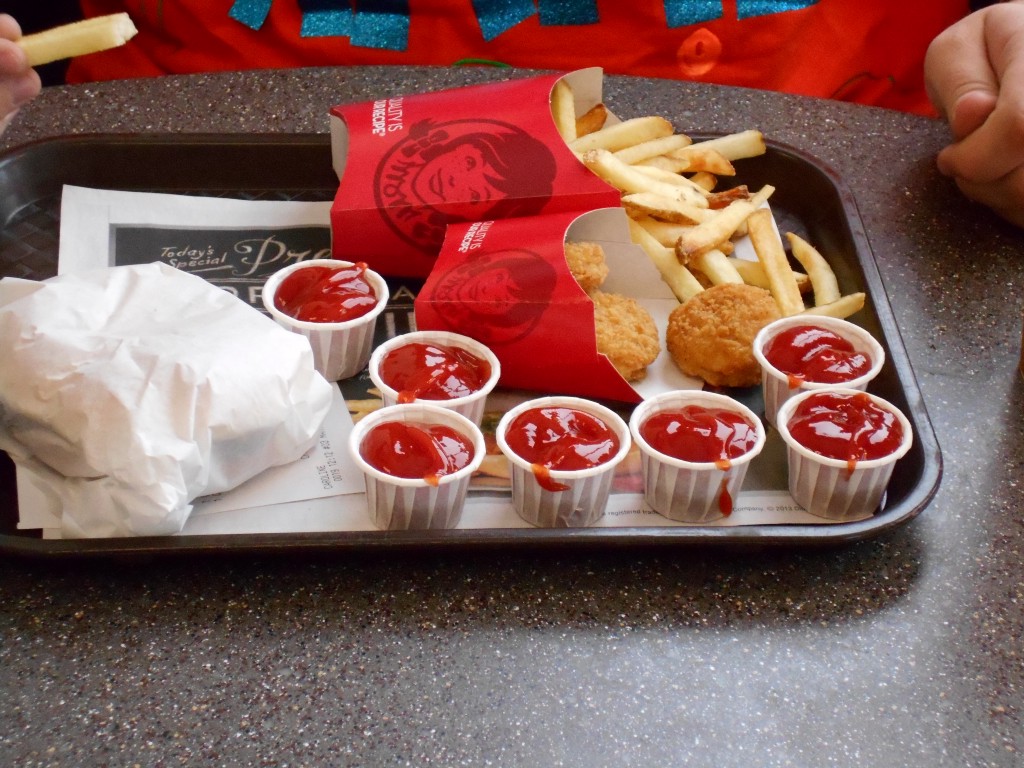
The top three condiments in The United States, by market value are: mayonnaise, ketchup, and soy sauce. Quartz published a report in 2014 pre-answering the question I would otherwise have gotten wrong had I not first Googled the answer—“What is the most popular condiment in America?”
Ketchup isn’t the king of American condiments. Mayonnaise is
For some reason a lot of us immediately go to ketchup, because french fries and hot dogs and monsters who put ketchup on their eggs. But the true smart alecks know that mayonnaise gets incorporated into lots of other foods, and only people who had already read that article and remembered it two years later know that the real source of the spike in mayo sales is the boom in the low-fat mayo market because cholesterol. Also now that veganism is cool and people care about whether their eggs were born in cages, there is a surge in the eggless mayo market, to the point of bad business practices—remember the Hampton Creek saga about Just Mayo?
Hampton Creek Ran Undercover Project to Buy Up Its Own Vegan Mayo
(Among other things, that story and all its ripple effects led to one of the greatest New York Times headlines, which in the future should serve as a test for proof of artificial intelligence if a robot can parse it: Egg Board Chief Retires Early After Move on ‘Mayo’.)
Okay, we get it—America is gross and loves fatty oily tastes in its gross sandwiches, to the point that the mayo business is more than DOUBLE the size of the ketchup business. Putting that aside, take a moment to think about the way we eat ketchup: the quantities, the forms, the various settings. You don’t go to a diner and find a glass bottle of mayo sitting out on the table, among other reasons because that would be disgusting as hell, but also probably sickening (if not deadly). You do get bottles of ketchup, and one of the first things you do if you’re the caricature of a busboy working your college summer on the Jersey shore is consolidate all the ketchups, right? Think of all that unused ketchup!!
Think about packets for a second, too. They do technically make packets of mayo but they are the secret shame of cafeteria sandwich-havers everywhere. You know you need it, but you wish no one had to see you holding it. Ketchup packets on the other hand: go nuts. Come home from the drive-thru with a paper bag that’s just full of ketchups. Stuff the junk drawer full of them. They don’t go bad, right? Not really! Anyone who’s ever inherited a desk at an office in any kind of news media organization knows that at any given moment, most of the top drawers have ketchup in them. It’s just a fact. Ketchup packets don’t go bad really, they just go kind of old. It gets brown and watery and you wouldn’t want to eat it, but unfortunately there’s just no way to know the difference between one of the old ones and one of the new ones without opening them and trying them.
Okay now think about your fridge. You probably have some ketchup in there. Have you ever in your life finished a thing of ketchup? Ever? Or have you just moved houses or apartments and been like, I guess I’ll just throw that half-empty squeeze-bottle out because I’m not going to put it in a hot moving van for ??? hours. Have you ever accidentally left the ketchup out overnight and then realized you’re not even really sure if you’re technically supposed to refrigerate it?
When you go out to eat, ketchup comes in either one of those steel shot glass thingies or you walk up to a pump dispenser and squirt some into a paper cup, because that is the proper amount of ketchup to eat. With mayo, you do not want to know how much mayo you are consuming, so there is very little measuring on either side of the food transaction, if we’re being honest. What this HAS to lead to is a glut of ketchup. There has got to be an overstock problem unlike any other condiment. There must be millions more ketchup packets in the world than there are mayo packets, that much is true. There are probably a lot of soy sauce packets from Asian takeout foods, but not nearly as many as ketchups. And people always take more than they need and then put the rest in the drawer. Is this ketchup waste? Probably. If you took all the leftover ketchup and consolidated it all together could you float the world’s ketchup supply for the next ten years? Maybe not. But what’s worse than having too much ketchup? Not having enough.
If you or someone you love has ever finished a bottle of ketchup from your fridge, please tell me more below.
The Punk Rock Gilmore Girls Book Group
Cookies and wine with ‘Please Kill Me’s Legs McNeil
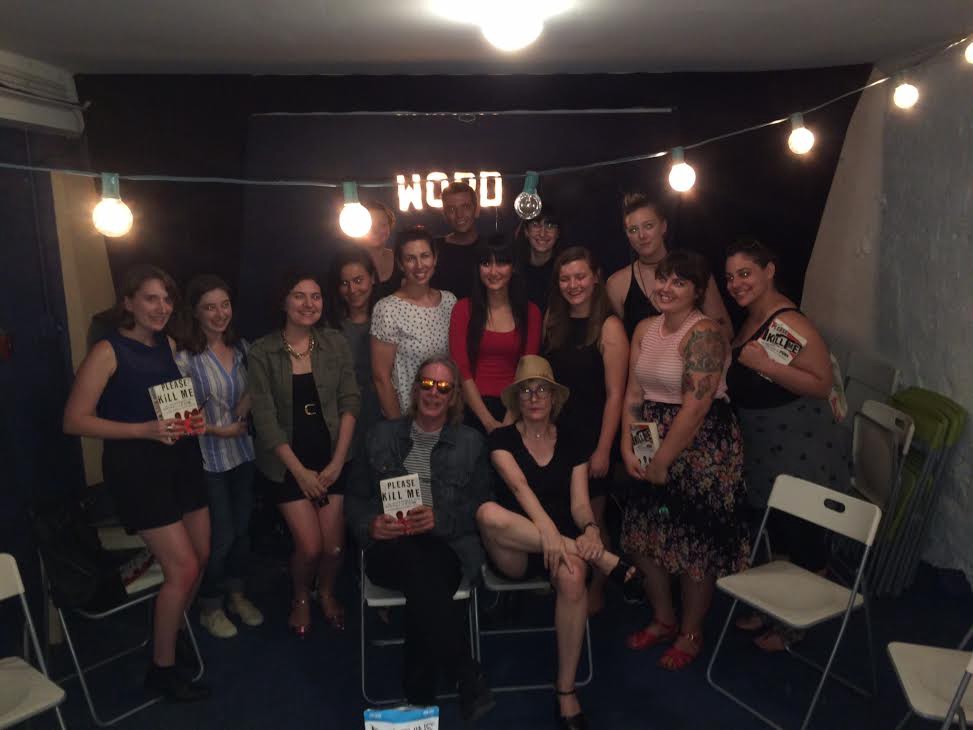
Legs McNeil doesn’t know what the fuck is going on. We are sitting in the basement of WORD bookstore in Greenpoint, along with Legs’s writing partner Gillian McCain and a dozen members of the Gilmore Girls Book Group, a club that meets on the fourth Sunday of every month “for a lively discussion of one of the books important in the ‘Gilmore Girls’ universe.” A woman in her late twenties is describing the complex set of emotions that fans feel toward Jess Mariano, Rory Gilmore’s ex-boyfriend.
“What the fuck is going on?” Legs whispers to me, possibly because I am sitting next to him but probably because he assumes (wrongly) that I have not watched this television show. I tell him that I don’t know, as a signal of my punkness, I guess. I am drinking rosé and eating a “Ginger Dead Boys” cookie with frowny face frosting.
The reason that Legs and Gillian have been invited here is that Jess lent Rory a copy of Please Kill Me: The Uncensored Oral History of Punk in the second season of “Gilmore Girls.” The extent to which Legs McNeil was made aware of this context remains unclear for the duration of the book club.

Most of the book group is holding the 20th anniversary edition of PKM, which Legs and Gillian have spent the summer promoting in an Ace Hotel-sponsored tour across the country. According to Legs, the reissue also marks the 40th anniversary of the Ramones playing CBGB’s for the first time. This is not quite true, in the same way that Legs’ claim that he invented the word punk is not quite true — the Ramones played their first show at CBGB’s in August of 1974 and Dave Marsh coined the term “punk rock” in a 1971 column for Creem magazine.
In any case, Legs first saw the Ramones at CBGB’s in the fall of 1975, and it was that night that Punk magazine really got its start. As recounted in the book, the Ramones couldn’t agree on which song to play, and ended up storming off soon after taking the stage. Amid the chaos, a 19-year-old Legs and his friend John Holmstrom spotted Lou Reed, who begrudgingly agreed to an interview for the first issue of Punk magazine. The three of them, along with Mary Harron (director of I Shot Andy Warhol and American Psycho) and “Lou’s transvestite girlfriend,” went out for cheeseburgers at Locale, where Lou Reed soon concluded that Legs was an asshole. He stuck by this belief until his death.
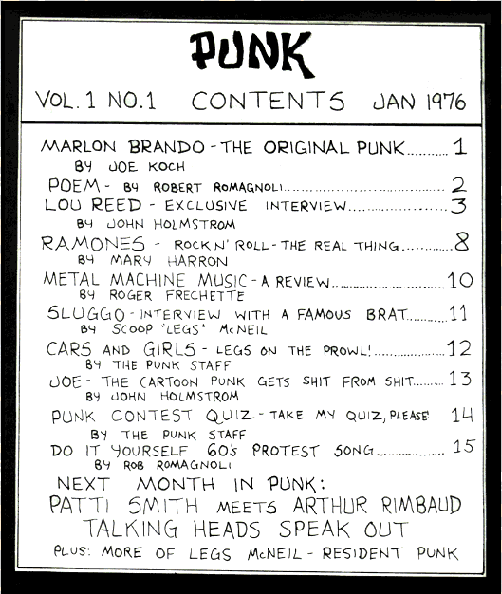
Back in Greenpoint, some members of the book group are wondering if their invited guest is a Nazi. We are discussing our favorite stories in the book, when, apropos of nothing, Legs tells us about this patch he’s designed: “A swastika blended with, like, a women sign, in front of some sweet chicks.” It is at this point that Legs excuses himself for the first of four smoke breaks he will take over the course of an hour.
Meanwhile, Gillian, who is much better at reading a room, asks each of us what band from the book we’d most like to see live. Answers are split 60/40 between the Velvet Underground and the Stooges, with a few outliers mentioning Television and Elvis Costello.
When Legs returns, he seems calmer. He tells one woman that Lou would’ve loved her. He expresses sadness about the many friends he’s lost over the years. He eats three Peanut Butter Patti Smiths and inquires about a Sixpoint on the craft table. “An IPA! What the heck is an IPA?” he says, maybe earnestly.
Someone asks Legs if he listens to any new music, and he says that he does not. At this point, the conversation turns — as it inevitably does when discussing literally any subject with people in this city over the age of 50 — to New York, and how it was once Good, but is now Bad. “Back then,” Legs says, “you could pay your rent by having your girlfriend strip twice a week.” People in the room shift uncomfortably, checking their phones.
He signs some books, takes a photo and leaves before we can recommend any of the excellent musical acts that appear on the show.

A cheap argument can be made here positioning Legs McNeil and the Gilmore Girls Book Group as emblematic of the city’s decline — the sleazy punk embodying New York’s former grit and authenticity; a book club based on a show set in the fictional Connecticut suburb of “Stars Hollow” as a symbol of the ever-sanitizing city. But that argument, like most arguments about things presumed to be worse now (America, Kanye West, etc.), would not be right.
Everything that is Bad now was probably Bad before, or else it was turned Bad by the very people who grumble about the days when things were Good.
The private equity bros who spoiled the Bowery are actually on the same team as Legs’s supposedly-punk Ace Hotel, which paid $30 million in 2014 to demolish the neighborhood’s longstanding homeless shelter. The marketing minds behind Barneys’ $590 “distressed” Superstar sneakers are working from the same logic that convinced Malcolm McLaren he could sell clothes by putting a bunch of working-class kids in a band and calling them the Sex Pistols.
Here’s a funny coincidence: On November 25th, Netflix will premiere the first new episodes of “Gilmore Girls” in almost nine years. The next day, the moneyed son of Malcolm McLaren and Vivienne Westwood has promised to burn his entire collection of punk memorabilia, valued at £5 million, as some sort of protest against state-funded concerts. Maybe there is a point here about the tide of culture, cyclic and advancing, hoisting along the vessels in which we choose to stick our nostalgia, however misplaced. Or maybe not.
Punk is dead. Long live “Gilmore Girls.”
Jake is a freelance writer in New York. He apologizes to any punk dads he may have offended.
Is CMJ Dead?
And how should we feel about it?

Not only have I aged out of seeing CMJ shows, I have aged out of being irritated that CMJ is happening, because I am rarely out late anymore and when I am it is not usually in or around the places that CMJ shows tend to occur at. But it turns out that CMJ shows will not tend to occur anywhere, anymore: This extensive Stereogum piece, which you should definitely read, says that CMJ is over.
CMJ Sure Seems To Be Over. So How Come Nobody Is Talking About It?
I’m a little sad. There is nothing worse for a New Yorker than being robbed of things to complain about, particularly things that young people, whose vibrancy and innocence reminds you of just how bitter and faded your own life has become, enthusiastically embrace. Sure, I’ll always have my disdain for the new NYU kids to keep me warm, but even that starts feel hollow the nearer I get to being the same age as many of the parents moving them in. Anyway, CMJ is dead. Read the piece above. There is some further, uh, background available here.
The Magnetic Fields: Live At Town Hall, New York City, March 11, 2010
The Last Days of Tekserve
Auctioning off the remaining goods from “the original Apple store”
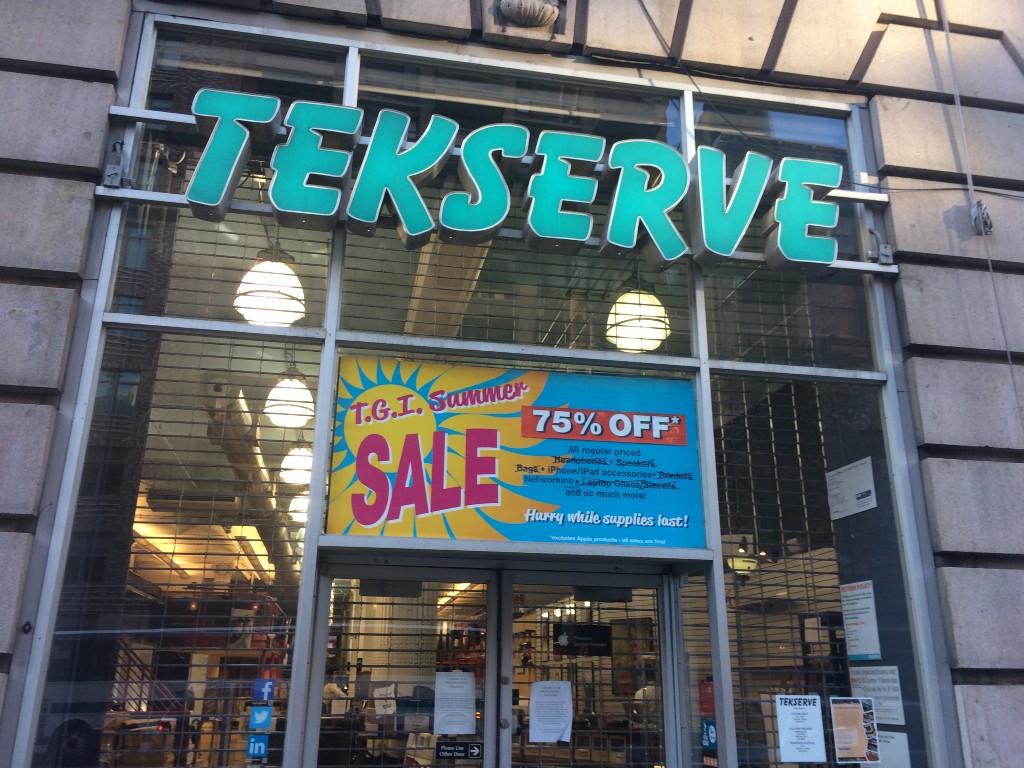
The independent technology store Tekserve was synonymous with all things Mac in New York City. But after twenty-nine years, its retail and customer service operations have gone out of business (the B2B arm will continue life as T2 Computing). It isn’t that the physical operation hasn’t made money — according to Crain’s New York Business, which included the company in its 2012 “Fast 50” list, Tekserve made nearly $100 million in 2011 alone from selling Apple products, third-party products and services. By 2016, however, there were seven Apple stores in Manhattan, the Best Buy down the street sold Apple products, and the landlord was planning to triple the rent. The store closed its doors on August 15th and held an auction one week later.
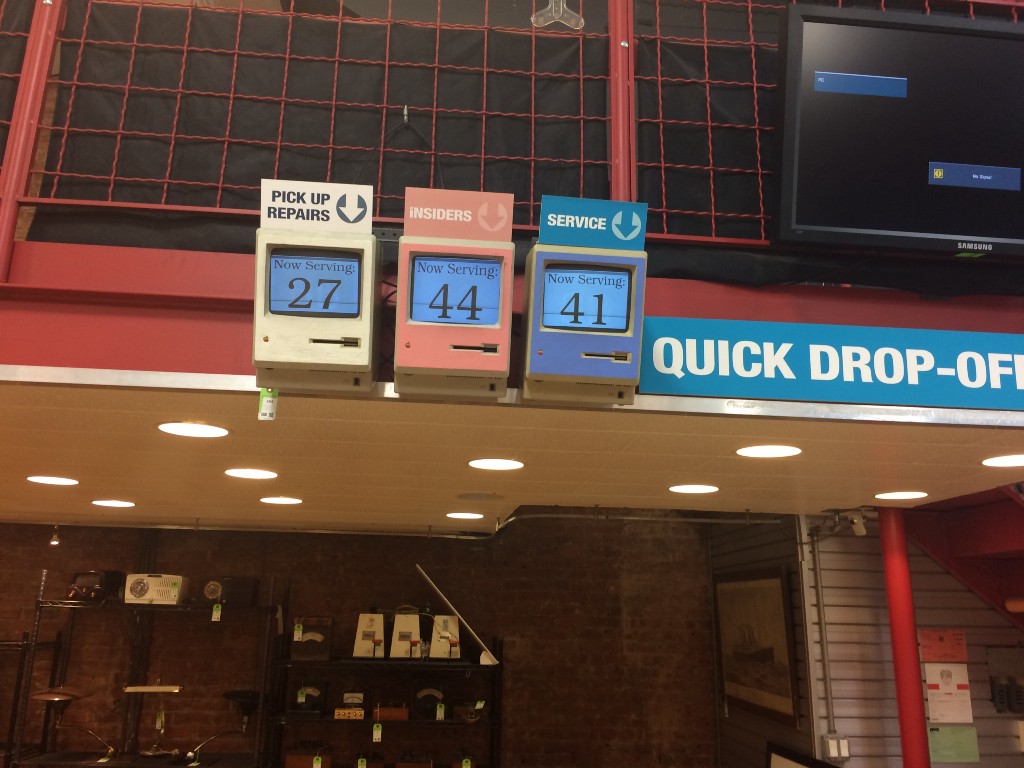
The place best known as the emergency room for busted Macs operated out of a 10,000-square-foot loft in Chelsea, its fifth location on the same side of the same block since it opened (the first was in the co-founder’s apartment). Customers were served in the order of the paper tickets pulled from old metal machines, the “now serving” numbers displayed on old Apple monitors. The place had its own gruff culture, with an impossibly world-weary staff. No matter what you asked them, you felt like a moron. It was just part of the experience. But as long as they fixed your computer that, yes, you did idiotically spill drinks on, who really cared?
Tekserve’s community farewell took the form of an auction featuring 601 items — much of which had been displayed around the store (with exceptions like a John Singer Sargent limited edition $550 print tucked away in a closet) and they were almost all from co-founder Dick Demenus’ private collection of technological and other assorted wonders. This included nearly two hundred vintage radios, a bust of Ben Franklin ($150); a “Think Different” Ansel Adams poster ($1600); a partial fossil of a starfish relative ($750); a blue, life-sized prop robot ($1500); a 1984 Mac computer, signed by Apple co-founder Steve Wozniak; and an entire thirty-five-piece vintage Mac collection that comprised the store’s “Mac Museum” and included an Apple Lisa.
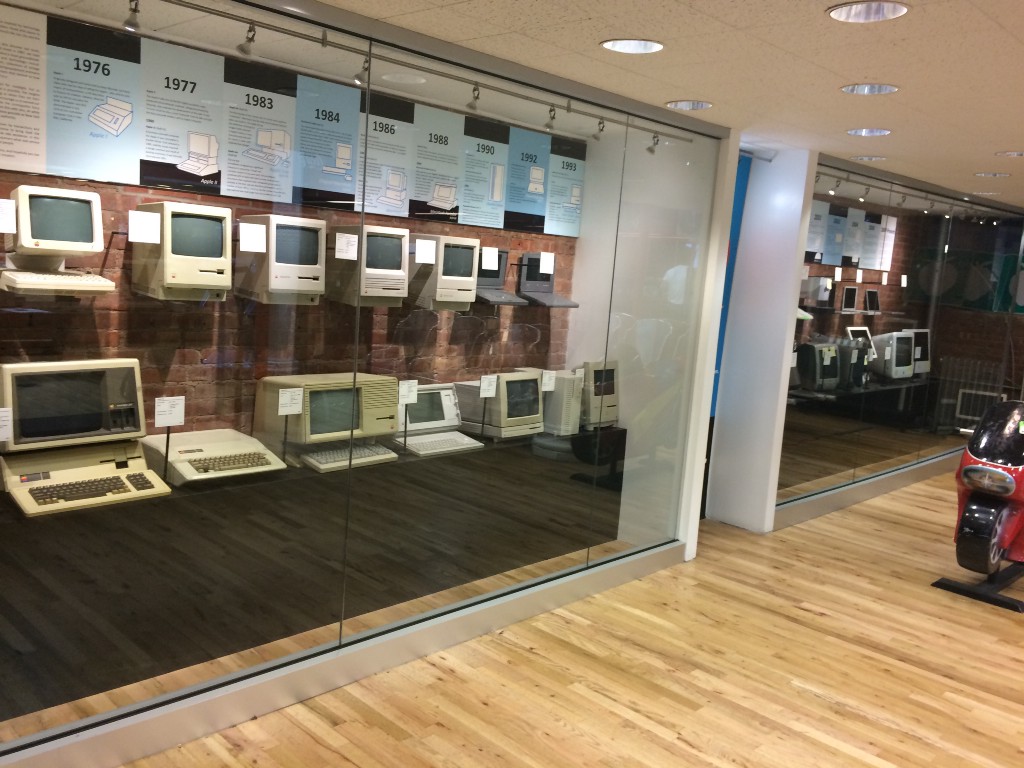
“Today’s emotional,” said sixteen-year veteran David Cook, who worked as Tekserve’s hiring manager, who took a breather to walk around the block after he became emotional. By his count, four or five different families were started by Tekserve employees. The atmosphere in the store that day was dominated by the current and former employees reconnecting. It was like a family reunion — if everyone in your family knew way too much about Apple. During individual conversations with several employees, others came up to give hugs, muse about the sadness of it all, and see what they were bidding on (radios).
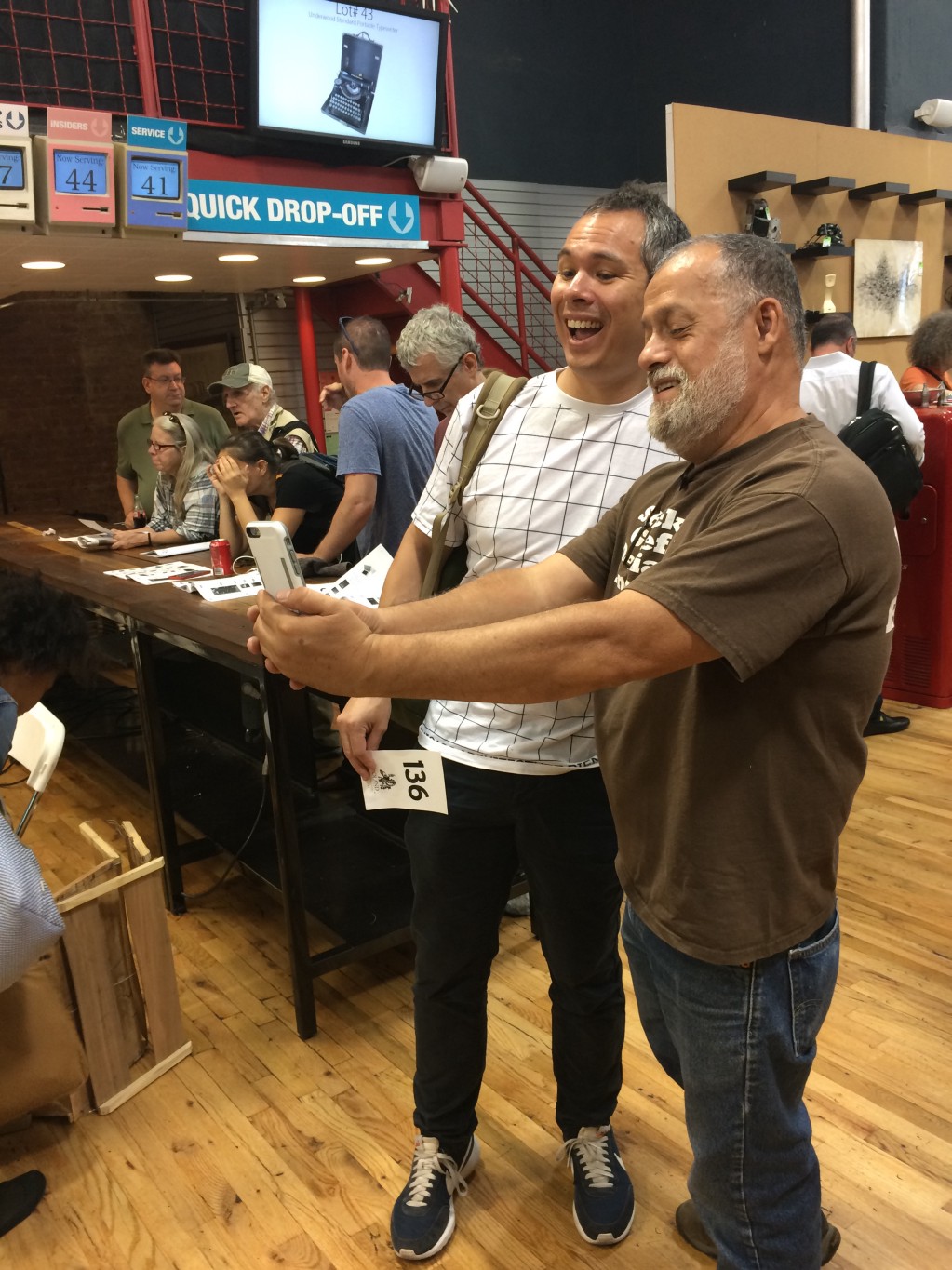
In-person auction attendees (the auction had an online component) also featured neighbors, Mac obsessives, and die-hard New Yorkers. Fifteen-year-old Zac Cohen, a Chelsea resident, bid on Lot 24, a red, three-foot-high kid’s toy motorcycle — “which works, I’m told,” remarked auctioneer Bill Roland (many items were unable to be tested before sale). Cohen had come with his father, David, who had been a customer of Tekserve since it opened. He said Zac had ridden the bike in the store as a kid, although he didn’t remember doing so. When the bidding reached $400, Zac kept going. “It’s a young man’s bid at $400,” said Roland, looking to Zac’s father for permission to continue. Although David indicated that this was as high as the family would go, Zac seemed unable to let the bike slip through his fingers, and raised again. When the other bidder in the room finally dropped out and Zac got the bike for $450, the room burst out in applause. He plans to display the motorcycle in his bedroom.
The auctioneer, through his 42-year-old company, Roland Auctions, usually handles more traditional estate sales and auctions. (One of his next events will feature political campaign buttons from “as far back as Abraham Lincoln.”) Roland admitted tech ephemera were new to him. “Did I say ‘Gollum’ right?” he asked as he sold Lot 301, an autographed “Lord of the Rings” promotional image that was signed, “Hey, you guys at Tekserve are “PRECIOUS!” … All the very best, Andy Serkis … Gollum!” ($225)
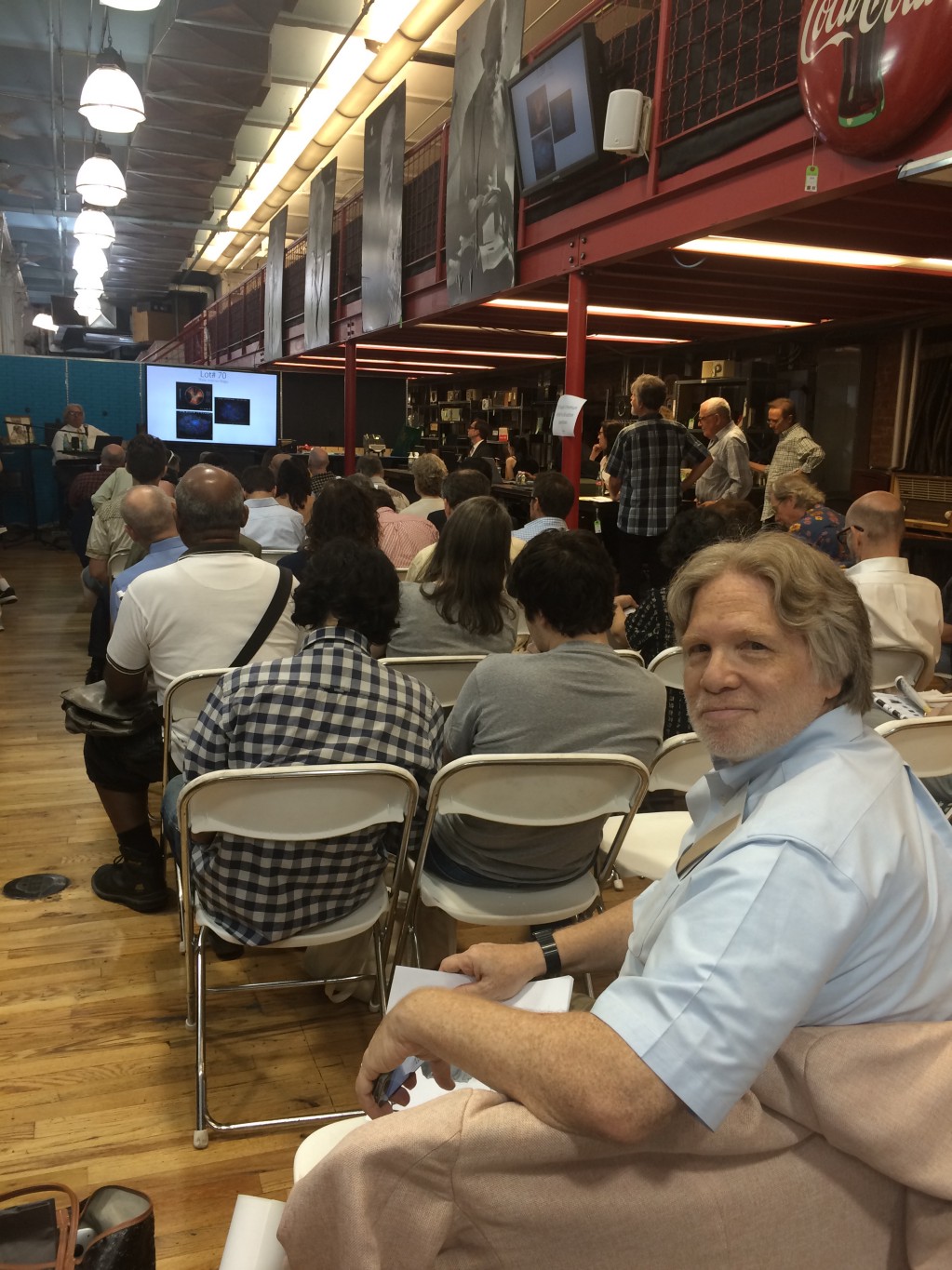
Seated in the back of the room was Tekserve board member David Rose, a serial entrepreneur, early-stage tech investor, and longtime New York tech booster, who had come to get a memento of Tekserve. He walked away with a “plunger detonator” ($850) but lost out on what seemed to be almost everyone’s white whale: “Someone outbid me for the Coke machine.” The vending machine in question, a vintage 5-cent Coca-Cola dispenser retrofitted to offer an 8-ounce drinks, went for $1900. Although most of the time the drinks in the store were free. “We often supplied the nickel,” said Jan Albert, the wife of the co-founder Demenus.
The face of the auction was the Salvador Dali-esque Lot 50 “Melted Macintosh Computer” (thanks to an internal fire). During the auction, Roland said his company thought the melted Mac was “funky enough” to make the cover of the auction catalogue. Remarked Tekserve co-founder Demenus, “I thought it would go for $100.” The man clearly did not know his audience.
It sold for $1200.
Theresa Rivera, who still works at Tekserve’s business-to-business arm T2 Computing as VP of sales, had her laptop open and focused on winning items at the auction. She wasn’t interested in buying any old computers; she already collects them. Rivera estimated that she has about thirty in total, and though she doesn’t have any room to show them off in her Long Beach home, she plans to buy a house upstate where she will. Rivera was bidding on typewriters and radios, the latter also a prize choice for David Yee, a former employee who now works for Vox as Director of Platform Engineering. “I want to have a reminder of working here,” Yee said. Yee worked for Tekserve twice, first as a desktop network technician, when he arrived in New York in 1996, and then after the tech bubble burst they “were kind enough” to hire him back, as the network administrator, while continuing to repair computers, according to his LinkedIn. Yee, who was an early hire, wrote in an email:
we were twelve people in a tiny loft down the street from where the business ended. David and Dick hired me despite my having the merest inkling of how to fix most Macs…All of us knew that we performed a valuable service to a certain segment of New Yorkers — people who used their Macs to publish Buddhist magazines, design children’s books, make music, run museums — and that we did it fairly. For those people, at that time (Apple was about to wander into one of the most dangerous periods of their corporate history, in which they nearly went out of business), we were the only game in town. It felt to me that we were a band of pirates, and as with most pirates, we shared a common bond that fostered both love and irritation. Some of the pirates went on to form life partnerships, others stormed out, but every single time I see a former coworker on the street, I give them a hug.
The auction lasted nine hours and by 3 p.m. the crowd had thinned out, but the diehards, and employees, remained. By closing time, total sales — including the buyer’s premium — hit around an estimated $190,000 — including the $47,000 hammer price for the “Mac Museum” alone. (Albert said the collection had been purchased by MacPaw, a Ukrainian start-up with an office in Santa Clara, California.) “Dick was down in the dumps and thought we wouldn’t get more than $20,000 for the whole collection,” said Albert. “He wasn’t a believer but I was.”
Many of the items scored a huge premium. Roland’s son Will, who helped with the auction, noted that director-style chairs with “Apple” and the company logo on the back can be had for $50 from other places, but went for $800 in the auction simply because these were from Tekserve. “And I don’t think [the buyers were] wrong.”
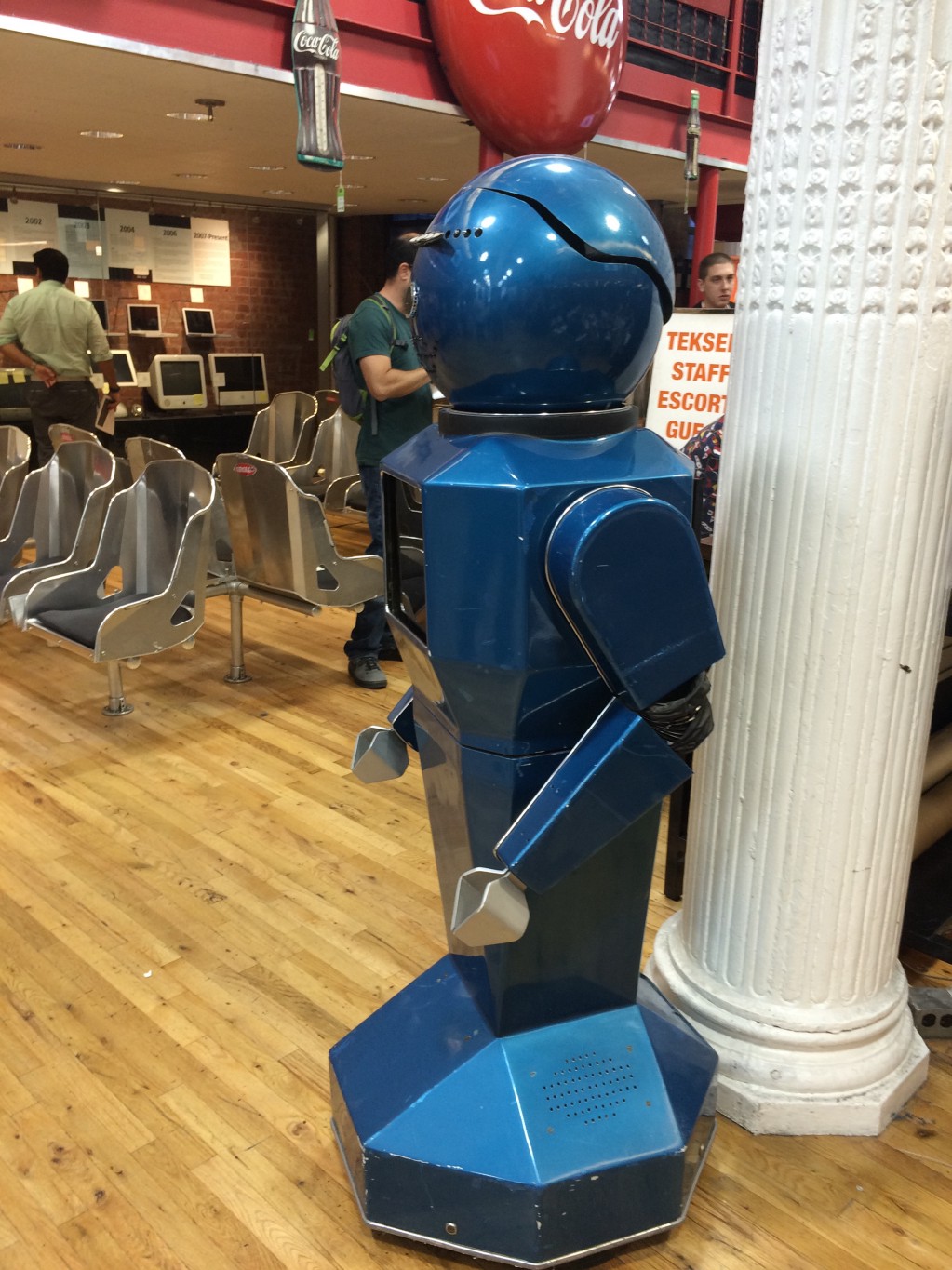
David Cohen, father of the young man who snagged the red motorcycle, said, “I’ve grown used to having Tekserve in the neighborhood. It’s going to be weird.” For those who worked at Tekserve, the auction may have seemed more of a wake than a celebration — but they, too, were glad to see a crowd that appreciated the objects they had grown to love themselves. Demenus remarked that selling the items to people who shared his enjoyment of them was far better than putting it in storage: “this way, people will enjoy the collection forever.” He did win one item back for his own enjoyment: the blue robot. “I’m fond of it,” said his wife, who bought it back at the auction. “It’s going to live in our country house in the Catskills.”
Bill Roland, who was doing running commentary while leading the auction, told the crowd, “I was told that if Steve Jobs were still here, he’d never let this place go.” The room collectively groaned. “Rest assured, you’ll never see another one.”
Caroline Waxler is a writer and a editorial director for live events. Follow her on Twitter @cwaxler
Aaron Sorkin Teaches You How To Win the Lottery
Notes from his MasterClass on Screenwriting
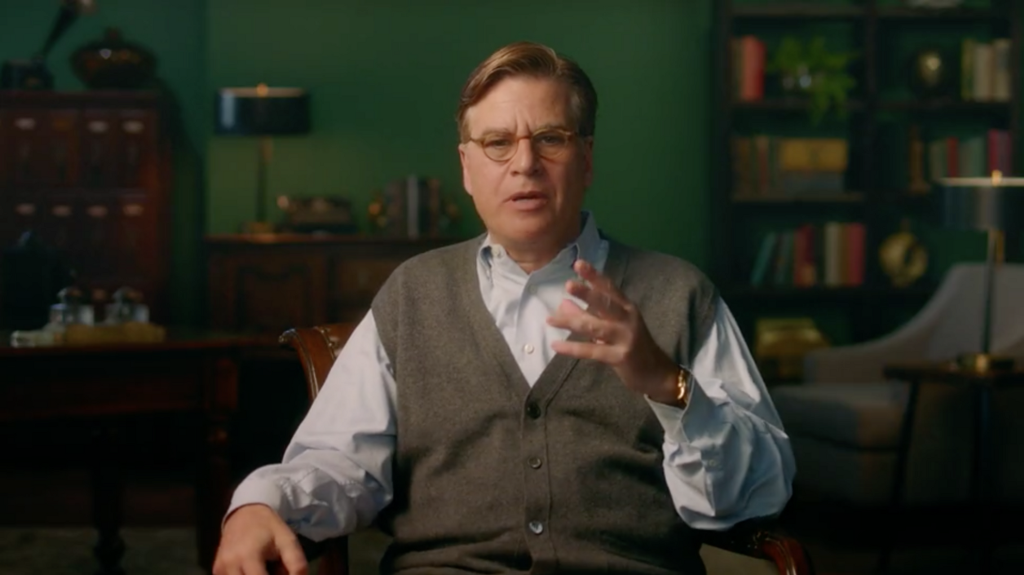
If you were casting a movie and needed someone to play a teacher of screenwriting, you would probably pick someone like Aaron Sorkin to play the part. He is a middle-aged white man. He wears sweaters. He has oval, bookish-guy glasses. His hair is still very good; a few strands of it artfully fall over his forehead in a way that may or may not be engineered. He makes insightful, put-it-on-a-poster observations while also saying “ah” or “um” with regularity, like a smart person who is not so brilliant as to seem unapproachable.
Aaron Sorkin wants to teach you screenwriting, for a new website called MasterClass that has a mysterious business model. They got some of the biggest stars in given fields to sign on as teachers — there’s Werner Herzog on filmmaking and Annie Leibovitz on photography — with more to come. Being a teacher (I’m not going to say “master”) means recording hours of teaching material in the form of direct-to-camera addresses or workshops where the teacher is interacting with students in a classroom setting. These are big names — quick, name a more famous screenwriter or photographer other than Aaron Sorkin or Annie Leibovitz who is also still alive. They must have paid them handsomely for their participation, and yet the class is $90.
I am suspicious of all of this.
Should you plow ahead, here are things you may notice while taking Aaron Sorkin’s screenwriting class:
- I may be confusing him with other middle-aged white men and their tendency toward a lack of self-awareness, but I am surprised by how humble Aaron Sorkin genuinely seems to be. He references an element of a previous show of his as “good” and then hastily corrects himself: “Not that I think it’s good writing…” and not even with undertones of “Peep how humble I am!!!” Maybe part of this is being a recovering addict, as Sorkin famously is; maybe when you’ve hit bottom, it’s impossible forever after to think of yourself as hot shit.
- He identifies himself early on as possibly a crap teacher because he has thought patterns that don’t move in particularly linear and helpful ways. He is a man who has written a lot about politics and knows something about expectation-setting — set the bar low, and it’ll be easy to top it.
- You will find yourself endeared, despite yourself.
- Aaron Sorkin once had a male character say “You’re a woman!” to another male character as an insult, so Aaron Sorkin and I are still not entirely okay.
- Within the first three classes, Aaron Sorkin achieves what no other screenwriting class I have taken has accomplished (and reader: I have taken some), in two ways:
- First, he explains the fundamental elements a good script — intention and obstacle — in a way that an entire giant copy of Robert McKee’s “Story” will not put quite so clearly. It’s the simple idea that you are sunk if your main character doesn’t want or need something that is believably difficult for them to get. He describes intention and obstacle as a clothesline that runs throughout your script — you need both for it to stand up at all, and only when you have both can you start adding more stuff to it.
- The second thing Aaron Sorkin does that no one else really does is acknowledge that making shit up is hard. Figuring out what’s going to happen in a story is really hard! The actual writing of it, the hands-to-keyboard part, is the fun part, but so much of writing is the figuring-shit-out part, and if you feel like you’re bad at it and it’s painful now at least you know that Aaron Sorkin finds it painful too.
- Aaron Sorkin specifically calls out writing scripts full of snappy dialogue in which nothing happens, making the viewer watching think back on his past work and say softly to herself, “Oh.”
- There are a series of student workshop sessions in which Aaron Sorkin sits in a room with five students and workshops opening scenes of scripts. Some of the scripts are incomprehensible and he gently asks “Did everyone understand what happened in this scene?” in a way that will bring you back to every creative workshop class you have ever taken.
- At one point, Aaron Sorkin makes a very dry joke about a continuity error that a student doesn’t understand as a joke and it’s awkward because Aaron Sorkin doesn’t want to acknowledge latent power structures.
- At the end of one session, Aaron Sorkin makes a big show of saying “Here’s your homework for tonight! Let’s all sleep on this!” And then, in the next episode that’s supposedly the next day, Aaron Sorkin and the students are all still wearing the same outfits as before. “So did anyone have a chance to think about this overnight?” he says. No, Aaron, I was apparently sleeping in my clothes? It makes you doubt everything: Are these kids real screenwriting students or are they actors? Are their lines, their work, all of it, scripted? What is the truth, MasterClass??
- During the student workshop Aaron Sorkin brings out a second pair of glasses, a reading pair, that he wears on a chain around his neck like an 19th-century New England schoolmarm, and you’ll will yourself further to not be endeared.
- Aaron Sorkin is only really cringe-worthy one time, and it’s when a conversation goes on way too long about a pitch he’s making to his students (IF THAT’S WHAT THEY ARE) on a show called “Mission to Mars.” It’s actually really clever — a workplace drama/comedy set entirely on a spaceship en route to Mars, where everyone knows they will probably die. But when the student-actor-kids don’t show as much enthusiasm as he would like, Aaron Sorkin says “Mission to Mars! Come on!” in the way that people watching sports will sometimes chide players for not making obvious connections on the field. The kids remain unmoved. You can see Aaron Sorkin wondering if the end of manned space missions has killed a sense of wonder in our nation’s youth.
- The class ends with Aaron Sorkin exhorting us to make original work that matters, which is inspiring in the way that Aaron Sorkin speeches can be if you’re a certain type of earnest person who likes Aaron Sorkin movies and television shows.

But in the end, I wonder what the point of any of this is (beyond returning the investment of whatever VC money was put into MasterClass as a whole). Unlike so much of continuing education — knife skills, art history, woodworking, photography — screenwriting is nearly useless as a form of art to practice or enjoy in its own right. A script, historically, is not a consumable product on its own. You can’t Kickstart or self-publish it. The movie is the product, and movies (and TV shows) have one of the highest barriers to production imaginable because they are, for the most part, fucking expensive to make at even minimum levels of quality. Because money is important, gatekeepers become important, and the usual rules apply to who tends to get past the gates. Very few people sell scripts, very few scripts actually get made into films or TV shows, in numbers such that the widest point of the funnel — writing a spec script without connections to the industry — approximates buying a lottery ticket.
Maybe this screenwriting course is more about learning how to appreciate film, or getting good enough to eventually get a job in a writer’s room, or just pass the time as an amusing hobby, but it’s not really sold that way. It’s sold inspirationally, as a way to make art, and in that sense, Aaron Sorkin might be a bit too Aaron Sorkin for the job.
Laura Olin runs The Awl’s newsletter, Everything Changes, and as a long-time professional Democrat is actually a secret giant Sorkin fan. You can follow her on Twitter at @lauraolin.
Angel Olsen, "Shut Up Kiss Me"
It’s about that time.

Tonight is the last time the sun will set after 7:30 PM until next summer, if we manage to make it that far. I’m not the only one who’s upset about it. I’m not ready for summer to be over! Why does anything that brings me joy end? I have so little. I feel like this happens every year.
Speaking of things that bring me joy, I have been listening to Angel Olsen’s My Woman nearly nonstop. It is terrific, it’s out Friday, I highly recommend you make it a part of your life. Here she is on last night’s “Late Show” doing “Shut Up Kiss Me,” a standout track on an album that is almost all standouts. Enjoy.
New York City, August 28, 2016

★★★★ Under the shadow of a cloud, things were moderate. Artificial gusts from vents, cold or neutral, stirred the otherwise sluggish midday air. Later on, the air had come to life. Sun reflected off a window and came to rest as bright spots on the curves of scavenged empty plastic bottles inside a sack. Trees and plantings were luminous in the places the light still could reach. The stroll over to the river looked quick and feasible. The Hudson was slightly grayer than the sky and striped with current out past the pier, where the tide was flowing in. A sailboat with a glowing jib headed upstream, moving fast. In truth, it was hotter there, looking west over the water, than it had been on the high ground. Back up on the shady ridge of Amsterdam Avenue, the breeze was strong and cool again.
Gene Wilder, 1933-2016
And now he’s dead.
There are very few good clips from The Producers, Gene Wilder’s first major film role, available online, which may be for the best: The Producers is easily one of the ten funniest movies ever made and if you haven’t seen it — or worse, if you only know it from the musical version — you should enjoy the total experience of watching it as God intended, as a complete film. Do that tonight, in honor of Wilder, who passed away today. Just to list some the titles in which he starred is to be reminded of the quiet yet profound part he played in the development of a certain kind of humor in the movies: Young Frankenstein, Silver Streak, Stir Crazy, The Frisco Kid, Willy Wonka, (I even liked The Woman in Red but I was not of a very discriminating age when it came out and have not seen it since), and of course Blazing Saddles, from which the clip above comes (and about which there are not enough disclaimers to be made in the current climate). He was a legend who never wore out his welcome, which is something that we rarely get to say about anyone anymore. Wilder was 83.
You Can't Smile Your Way To Happiness
It’s hard to believe that grinning like a shmuck won’t somehow make you more at ease with the horrors of existence, but Science has come around to the idea that it won’t.

It turns out that forcing yourself to smile will not somehow trick your brain into being happy, because even though it sucks and is sad and it can’t see the good side in anything most days, it’s not stupid, your brain. It’s not going to say to itself, “Oh, my mouth is smiling now? I guess I’ll just forget that everything is terrible and only getting worse, that anything I do is a waste of time and that life is filled with lies and emptiness! Zip-a-dee-God-damn-doo!” Have you ever been told to smile because you were looking sad? Of course you have. Did it ever cheer you up? Of course it didn’t. It’s bullshit, like every other thing people tell you do to so that they don’t need to contend with your discomfort at how horrible life is since they are just barely managing to keep themselves from confronting it in their own miserable minds.
That said, there are indeed ways to trick yourself into thinking that everything might be okay. They are, in descending order of usefulness/enjoyment: drugs and alcohol, sex, sugar and fat, imagining how peaceful things will be when you’re dead, spending time with friends (this is sort of a repeat item since it requires alcohol for maximum enjoyment), extended stays in exotic locations, listening to songs you like, savoring the failures of your enemies and the occasional bout of exercise. You will note the flaw in all of these strategies: They are unsustainable and they eventually do more damage to you than the benefits they accrue, particularly exercise, which I only put on this list because I don’t want to hear from the people who are always like, “Have you tried exercise? Exercise will change your life, let me tell you how it changed mine” and on and on for another three hours at which point you are ready to take up running just to get as far away from them as fast as possible.
Anyway, the point is this: Happiness is mostly an illusion, but it is a difficult one to trick yourself into believing. It’s mostly something that happens to other people, and they only have access to it for the same reasons that some people never floss but still have perfect teeth: good genes. Really, it’s your parents’ fault you’re so unhappy. Maybe knowing that will cheer you up a little.
